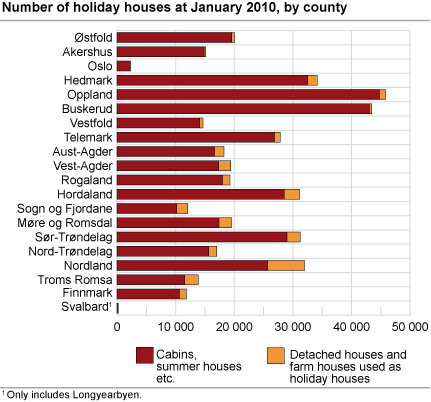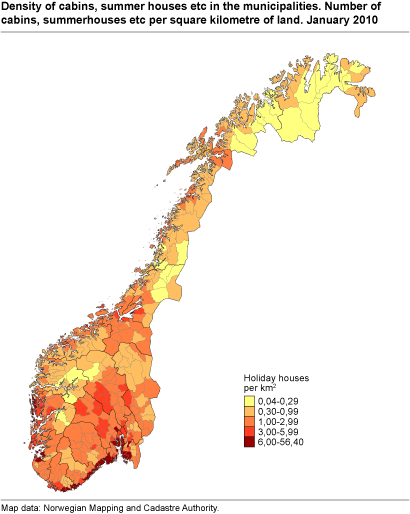Content
Published:
This is an archived release.
One in three multi-dwellings are in Oslo
Statistics show that almost every third multi-dwelling building is in Oslo. There are 3.9 million buildings in Norway, whereof 33 306 are multi-dwelling buildings. In Oslo there are 10 478 multi-dwelling buildings.
More than one third of the building stocks, 1.5 million buildings, are buildings for residential purposes. The remaining building stock consists of about 1.7 million holiday houses, garages etc., and about 745 000 other non-residential buildings. More than 0.5 million buildings belong to the agriculture and fishing sector.
Almost 430 000 cabins
The building stock had a net increase of 5 398 cabins last year, whereof 616 are detached houses and farmhouses used as holiday houses. Most municipalities have had minor changes in the building stock. The greatest changes have been in the municipalities of Ål, Trysil, Åmot, Grong, Ringebu and Vinje, which all had a net increase of more than 100 cabins each. Except from Grong municipality, all the municipalities have a large number of cabins.
Foundation for statisticsThe statistics are based on data from the Ground Property, Address and Building Register (Matrikkelen). The municipalities record data in the Matrikkel. All buildings in Norway larger than 15 m2 are to be recorded in the register with a code for building type and coordinates. The statistics may include buildings that are torn down, burnt down or otherwise non-existing, if not reported to the municipality. Connected units are recorded as separate buildings when the units can be torn down independently of each other. A single dwelling in row houses and in semi-detached houses is recorded as one building. Causes for changes in building stockMunicipalities clean their registers at different intervals to improve quality. As a result, buildings that were not classified one year are assigned their correct building type the following year. In addition, incorrectly classified buildings are assigned their correct building type code. The number of registered buildings in a municipality may therefore change from one year to the next. |
Tables:
- Table 1 Existing building stocks at January 2010. County
- Table 2 Existing stock of residential buildings at January 2010. County
- Table 3 Existing stock of non-residential buildings at January 2010. County
- Table 4 Number of holiday houses at January 2010. County
- Table 5 Number of holiday houses per square kilometer, by municipality. January 2010
Contact
-
Jens Mathiesen
E-mail: jens.mathiesen@ssb.no
tel.: (+47) 40 81 13 98
-
Mona Takle
E-mail: mona.takle@ssb.no
tel.: (+47) 40 81 14 12


